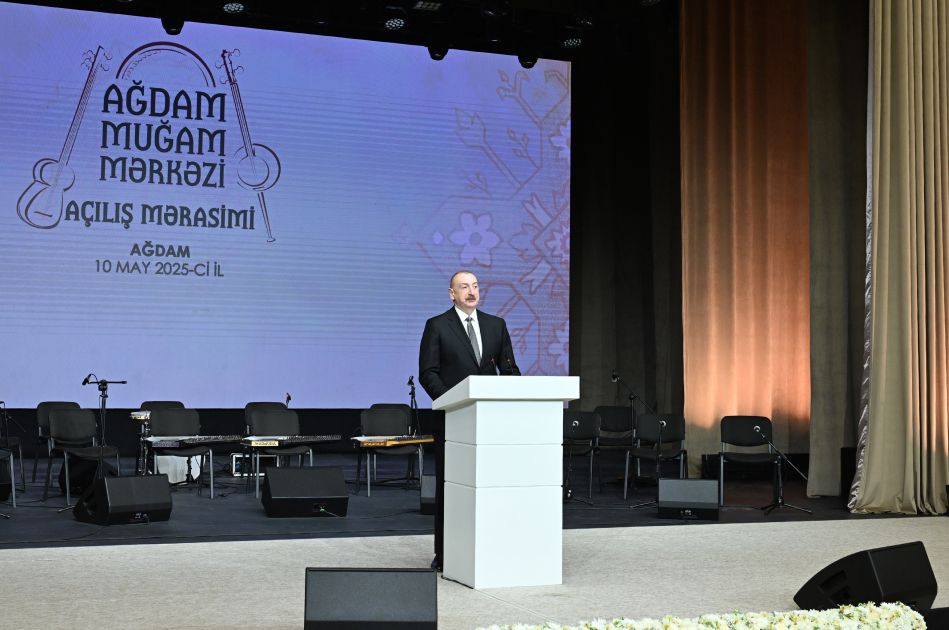President Aliyev’s Aghdam visit signals strategic shift from recovery to transformation

The recent visit of President Ilham Aliyev to the Aghdam region of Azerbaijan marks more than a ceremonial gesture – it is a strategic reaffirmation of Azerbaijan’s long-term commitment to revitalising the territories liberated after the Second Garabagh War. Four and a half years after the cessation of hostilities in 2020, Azerbaijan is now visibly shifting from post-conflict recovery to a robust phase of socio-economic transformation.
With construction underway at full pace, the restoration of Aghdam – once referred to as the "Hiroshima of the Caucasus" due to its total devastation during Armenian occupation - symbolises the broader revival of Garabagh. President Aliyev’s presence at key infrastructure inaugurations serves a dual purpose: reinforcing the political sovereignty of Azerbaijan over its reclaimed lands and projecting the success of the state-led reconstruction model to both domestic and international audiences.
One of the highlights of the President's visit was the inauguration of the Aghdam Railway and Bus Station Complex. This facility not only reconnects Aghdam to national transport arteries but is also part of a broader infrastructure strategy aimed at regional reintegration. Situated at the crossroads of the East-West and North-South corridors, the new transport hub will enhance economic connectivity, facilitate returnee resettlement, and stimulate interregional commerce.
Aghdam transport hub inaugurated as cornerstone of Azerbaijan’s corridor strategy
The reopening of transport links also plays an essential geopolitical role. It reinforces Azerbaijan's position as a transit and logistical hub in the South Caucasus, capable of managing major corridors independent of regional power influences. In this regard, the restoration of the Aghdam-Khankendi railway and future connections to Shusha via road and possibly a cable car align with a wider state vision of seamless, sovereign infrastructure across all liberated territories.
The launch of the first phase of Kangarli village further underscores Azerbaijan’s emphasis on sustainable resettlement and rural development. Designed for 2,544 residents, with comprehensive infrastructure including utilities, schools, and cultural facilities, Kangarli represents a blueprint for modern, planned reintegration of internally displaced persons (IDPs) into their native lands. Such development is not merely about rebuilding homes; it reflects a deep strategic priority to repopulate and reanimate areas left barren for decades, turning them into productive nodes of the national economy.
President Aliyev's interaction with newly resettled families and the presentation of house keys highlighted a personal and political symbolism – emphasizing state responsibility in reversing the effects of three decades of displacement. Moreover, this grassroots-level rehabilitation feeds into national cohesion, addressing the psychological and cultural wounds of the past.
In his remarks, President Aliyev underscored the scale of destruction inflicted by Armenian forces during the occupation – noting that much of the damage occurred not in the heat of war but under ceasefire conditions. His strong language - referring to "genocide," "urbanicide," and "ecocide" – points to an ongoing effort to frame the occupation not only as illegal but as an affront to human and environmental rights.
This framing is not without strategic value. By continually invoking international norms and the inaction of certain global actors, Azerbaijan seeks to maintain global attention on the Garabagh issue while discrediting narratives that undermine its territorial integrity. Simultaneously, these statements bolster national unity by reminding citizens of their shared historical struggle and ultimate triumph.
Perhaps most significantly, President Aliyev positioned Azerbaijan’s post-war reconstruction as a potential global model. “I do not know any country where construction and development projects of such proportions are progressing,” he stated, underscoring that these projects are funded from national resources and reflect indigenous planning capacities.
This assertion has analytical weight. While many post-conflict regions rely heavily on international aid and NGOs, Azerbaijan has largely financed reconstruction through oil revenues and state budget allocations. This model – centralised, state-led, and symbolically rich – differs from the decentralised, donor-dependent approaches seen in other post-conflict contexts.
Cultural revival and soft power
The President also highlighted the cultural dimension of recovery, noting the restoration of historical sites like the Aghdam Juma Mosque and the planned mugham festivals in newly built cultural centres. By reviving cultural heritage and promoting the return of artistic traditions, Azerbaijan is not only restoring physical infrastructure but also reclaiming the cultural narrative of Garabagh.
This use of cultural soft power has both domestic and international significance. Domestically, it fosters identity restoration for communities long estranged from their heritage. Internationally, it signals the peaceful and inclusive nature of the reconstruction process, countering allegations of exclusivity or militarism.
President Ilham Aliyev’s visit to Aghdam reflects a multidimensional strategy encompassing infrastructure, resettlement, historical justice, and cultural revival. It is a powerful narrative of transformation – one that seeks to convert past destruction into future development
Here we are to serve you with news right now. It does not cost much, but worth your attention.
Choose to support open, independent, quality journalism and subscribe on a monthly basis.
By subscribing to our online newspaper, you can have full digital access to all news, analysis, and much more.
You can also follow AzerNEWS on Twitter @AzerNewsAz or Facebook @AzerNewsNewspaper
Thank you!

